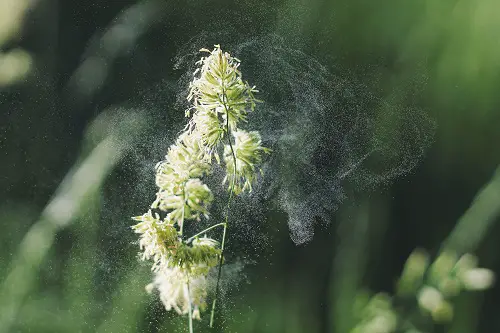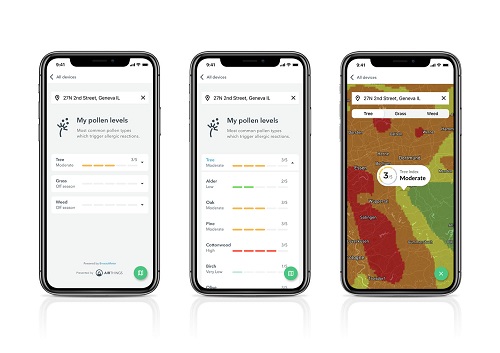An air quality monitor cannot single out which particles are pollen and which are not. Pollen is somewhere between 2.5 and 100 microns in size depending on the type of pollen. Since most air quality monitors only measure particles with a size of 2.5 microns or smaller, pollen isn’t usually detected. Some air quality monitors, however, are able to give an indication of pollen levels based on local outdoor pollen data.

Air quality monitors can detect particles, gasses, and conditions of the air such as temperature and humidity. These monitors are designed to detect small amounts of potentially harmful compounds. They focus mostly on the commonly occurring compounds in households and offices. This does include pollen. However, pollen is lumped together with other airborne particles. This makes it impossible to tell if the measured particles are pollen or something else.

How particles, including pollen, are measured
Air quality monitors can measure particles in the air, including pollen. However, they measure these particles based on their size. This results in not being able to tell what particles are measured exactly, leaving us guessing if they are pollen or something that doesn’t trigger pollen allergies.
Normally, the size of airborne particles is what matters most. If particles are relatively large, they will be caught by our nostrils and not enter our lungs. The smaller the particles, the more harm they can do to our lungs. They can do more harm because they can reach further into the lungs, damaging more fragile parts.
Particle size is often differentiated in PM1, PM2.5, and PM10. PM stands for particulate matter, small airborne particles also known as fine dust. The number indicator is an indication of their maximum size. PM2.5, for example, is an indicator of particles of 2.5 microns (µm) or smaller (a micron/micrometer is one-millionth of a meter or 1/25.000 inch).
Pollen is relatively large
According to Wikipedia, the smallest pollen particles (from forget-me-nots) are 2.5 to 5 microns (µm) in size. The largest pollen is about 90 to 100 µm. The average pollen size is around 20-25 µm (source).
This means that air quality monitors that measure only particles the size of pm2.5 or smaller won’t detect most pollen. To be able to detect pollen at all, an air quality monitor needs to measure PM10. PM10 includes all particles with a size of 10 microns or smaller.
Normally an air quality monitor measuring PM10 means they have a less sensitive sensor. PM10 cannot differentiate between relatively large particles of 10 microns and smaller, more harmful particles. However, if you want any indication of the presence of pollen, PM10 measurement is required. But again, there is no way of knowing if these particles are pollen or something else.
Because of this, most air quality monitors will not help with the detection of pollen. However, some monitors have some additional tools to help, such as a pollen indicator.
Airthings app: My pollen levels
Airthings is one of the top brands for indoor air quality monitors. They have several excellent air quality monitors available and I have written plenty about them on this website.
One of the extra features that come with Airthings products is their free app. This app, next to showing the air quality data detected by the monitor, also has a section called My Pollen Levels.
This function shows data based on outdoor pollen levels, helping you get a better idea of whether you have pollen indoors as well.
The My Pollen Levels function shows the following:
- The relative amount of pollen on a map
- What source the pollen is coming from. (Trees, grasses, or weeds)
- More specific data on the presence of common allergy-triggering pollen

On top of that, the app is designed to let you know when to either:
- Turn on air filtration units like your AC
- Start purifying the air with an air purifier, or
- Close your windows to block out incoming pollen
An air purifier can help against pollen
If you want to get rid of pollen in your house, you should consider purchasing an air purifier. Air purifiers do not (usually) measure the condition of your air, but they actively clean it. Purifiers have several filters that trap airborne particles which are blown through the machine using a fan.
Normally, the tiniest particles are the most harmful and require the best, most expensive filters. For pollen, however, relatively cheap filters will do the trick. Since pollen is quite large, they easily get caught in regular air filters. Therefore, you will not have to purchase the best and most expensive air purifier to relieve some of the pollen stress.
If you want to know more about air purifiers, I recommend starting with: How to know if you need an air purifier. This article includes information about what an air purifier does and doesn’t do next to when you need one and which type of purifier is best for you.
